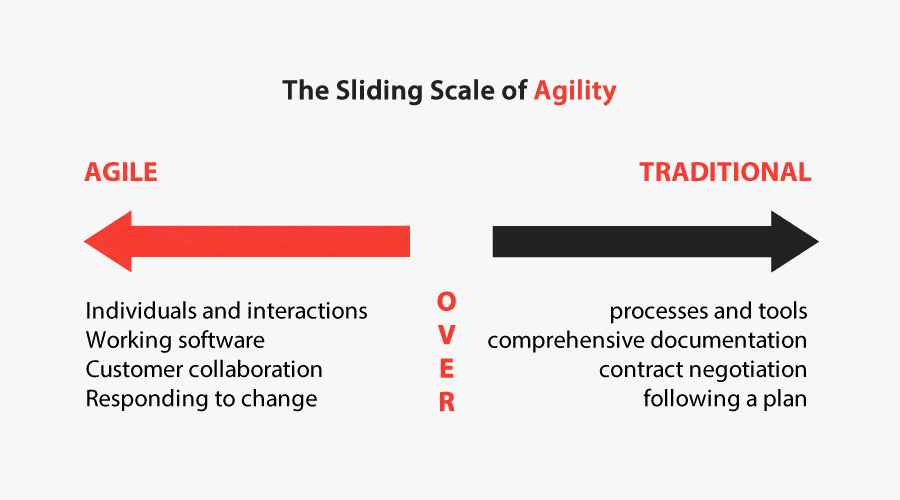Are you a Traditional or an Agile web designer?
Recently, on the WP Builds Podcast, we put out a discussion called “Realistically defining our business model”.
It was the first in our Business Bootcamp series where we’re relearning everything we know about building sites and running a design business.
For contrast Nathan (the host) agreed to take the role of representing a traditional approach while I’m going the Agile route.
What became clear to us was just how important it can be to pick an approach that best fits our personalities.
I thought it was a topic worth exploring further. In order to do this I’ve invented four web design characters
- The entrepreneur
- The artist
- The fixer
- The enabler
I’m looking to see whether a Traditional or Agile approach might suit these best. To help, I’ve set up this scale of agility using the four values from the Agile Manifesto.
On the right is the traditional model where what is delivered at the end is determined by what was agreed before the process starts in earnest.
On the left we have the agile model where the end is determined by what happens as part of a collaborative and iterative testing process. In theory there is no end because change is inevitable.
The entrepreneur
They want to grow their businesses. Ideally, they want to develop them so they can run without them, allowing them to sell them should they want to.
They are most likely to Value Price projects and set minimum cost for projects to exclude lower or even typical budgets.
They are dynamic, good at selling and are probably heard the most in web designer circles.
I believe they are most likely to remain on the traditional side of the scale because:
- Fixing internal processes and tools along with planning are the key ways in which they try to work on their business rather than in it.
- Successful value pricing usually depends on defining a clear end deliverable upfront.
- High ticket projects tend to require more contract negotiation.
The financial rewards are potentially higher with this model but so are the risks.
The quality issues that started the Agile movement are most likely to be found in the longer high cost projects.
The entrepreneur will either need to pick projects carefully or will need charm, a thick skin and a good lawyer.
Of course, they could employ agile practices. In fact, self determining Scrum teams seem perfect for the entrepreneur who wants to hand the day to day jobs to employees.
But, if the team is working to a fixed end deliverable it’s not agile in principle (and Scrum masters could end up micromanaging) .
The artist
They could be trained graphic designers who started in print and learned web design because it’s where the work went.
Their skill set has evolved to include the technical side of building sites and digital marketing, but these are secondary to their visual design skills.
They’re likely to see themselves as professionals first and business owners second.
For them the traditional approach (that worked for print) could still work best for brochure sites; if the client trusts the designer to deliver the best for their target audience and lets them get on with it.
Often, it’s not that easy:
- If a client is too detached from the process they may seek outside opinions that are based on personal aesthetic rather than visitors profiles.
- Unlike print, websites are more interactive, requiring UI/UX skills and design has to respond to the device accessing it.
- It has a more direct and measurable impact on the owner’s business and is powered by ever changing technology.
- The artist may want to avoid the cycle of famine and feast that comes with this type of business and will be moving to an ongoing maintenance relationship.
For good reason, the artist may prefer to create in isolation where they can retain control and consistency.
But websites can include complexities that go beyond the visual aspects. This gives them more reasons to consider closer collaboration and more iterative work with clients.
I plan to explore agile approaches to visual design later, but hopefully you might see that simply removing the Ta-Dah! reveal moments from a design process could reduce the dreaded client revisions list (and last minute compromises that leaves no-one truly happy)
Some key benefits to going agile could be:
- It can put the clients in control of the budget for revision. There is no reason to have to lose out if they want to experiment.
- The client has longer exposure to how the designer’s process is about finding empathy with the visitor (making it easy for them to navigate the story there and feel at home).
- The designer gets more exposure to the character of the business and it’s customers.
I’ve heard some large agencies budget time for informal get-togethers so they can internalise the character of the business they are representing.
The fixer
For the fixer, web design, is more like a series of business and technical problems to be solved with logic
They are likely to concentrate on the more dynamic and functional website.
In terms of this audience they are likely to be implementing solutions like WordPress rather than being a full stack developer.
They may focus on ecommerce, membership sites. learning management systems (LMS), directory sites or events booking.
Even if not, WordPress implementers would probably work a lot with custom post types (CPTs), Custom Fields and are likely to do more with a forms plugin than simply add it to a contact page.
Like the artist, their business tends to rely on their personal skills and they could be happy with both Traditional and Agile approaches
For example, the requirements of an ecommerce site are often similar. The page layout and UX tends to follow a set of (already user tested) conventions.
The designer doesn’t need to reinvent the wheel and they (arguably) don’t require a level of aesthetics that might be prized on a brochure site.
Assuming they can get a solid list of what the clients want (such as upsells, subscriptions, delivery notes etc) the traditional model seems the better option because:
- Both parties will be clear upfront what needs delivering.
- The type of implementation leaves no role for the client.
- With large WordPress plugins, functionality is not iteratively added to the platform.
However, with other situations where they are using flexible plugins (Pods ACF, Metabox, Gravity Forms etc) or coding themselves to create more customized solutions an agile approach may be better (for the same reasons it is preferred by software developers).
The enabler
The enabler is a generalist. A Jack of all trades (and master of none). They enjoy the variety and the self-sufficiency this brings.
Being self-reliant (perhaps through working on their own projects) they don’t have much time for areas of contentions when working with others.
If a client has no copy or budget for a copywriter, the enabler is likely to take on the role just to see progress is made.
Some might mistake them for people pleasers, but not aligned to any particular discipline they see themselves as pragmatists.
Equally, they are open to handing over work to anyone who could help achieve a better result. This could be specialist designers, developers, marketers and SEO’s etc that equally might come from the clients team.
The important thing for them is that the project keeps moving forward smoothly as if it would have if they did it all themselves.
I suspect this describes many here as I pitched this blog to freelancers and small agencies who “do it all”.
It’s always been my situation and I believe this type can most benefit from adopting an agile approach. It could give them a model that allows them to work with others and structured way that is not a fight for control,
Prior to understanding the agile movement I felt out of place as all the training on running a web design business seemed to focus on the traditional values of processes, planning, documentation and negotiation.
Much was about establishing a clear Us and Them in terms of what is expected from the designer and client. This did not match my own positive work experiences.
In my youth I scraped a living as a musician. The most creative work I observed almost always came from unlikely collaborations and “jamming” sessions where iteratively the seeds of someone’s idea would turn into something far greater than the sum of its parts.
It could not be planned. Ideas needed to fail fast to get to the ones that could unpredictably be developed better.
Later as an employee I was promoted to a manager role where essentially my job was to monitor lone workers and see they did things the way the office wanted.
It didn’t sit comfortably with me, as I got there by mostly ignoring what the office said.
My staff team was the same. They passed on my ideas too… and were better for it.
Thanks to Daniel Pink’s theory of motivation (which I later learned gets referenced in how to run an agile team) I realised the best thing I can do is reduce the insistence on following processes and give staff trust, autonomy and a way to share their ideas with others.
It earned me a reputation as a slack manager with an unruly team who spent too much time socialising, but it worked.
The team picked up Excellence Awards and the work was more enjoyable.
Of course, with each of these, the very opposite could be argued.
- A classical composer notates everything that musicians play in an orchestra.
- Autocratic managers also develop effective teams.
What I am mainly highlighting is that there is not one correct approach to running a web design business.
The traditional model remains dominant in web design circles, but it is not right for every situation.
I believe we are the happiest when we find the approach that is most in keeping with our personality and what motivates those we work with.
I would love to hear your thoughts on this





